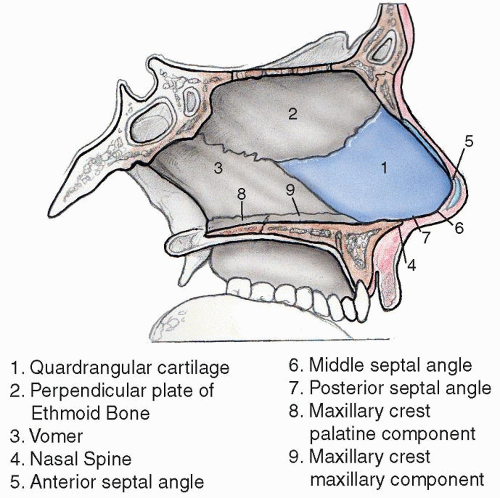History
It is essential to obtain a thorough history when assessing a patient with nasal obstruction. The clinician should pay particular attention to unilateral versus bilateral symptoms, onset, seasonal variation, and associated nasal symptoms. The nasal cycle is a periodic alteration of engorgement of the erectile tissue in the inferior turbinates, typically cycling every 2 to 7 hours, with subsequent changes in nasal airflow. Mucosal inflammation caused by rhinosinusitis or allergic rhinitis may exacerbate the normal nasal cycle. Unilateral nasal obstruction, especially with epistaxis, could be a symptom of a sinonasal neoplasm. Obstruction, either unilateral or bilateral, following nasal trauma may indicate a fracture or structural abnormality of the nasal septum or pyramid. Obstruction that fluctuates seasonally or with environmental exposure indicates a reversible mucosal abnormality rather than a fixed structural obstruction. Associated symptoms, including facial pain or pressure, nasal discharge, and hyposmia may indicate rhinosinusitis. Nasal obstruction, associated with serous otitis media requires evaluation of the nasopharynx for possible neoplasm. Nasal obstruction can also cause nonnasal symptoms such as dry mouth, sore throat, snoring, halitosis, and decreased appreciation of taste sensation, presumably from impaired smell.
In addition to eliciting subjective complaints, one must also review the patient’s past medical and surgical history, current medications, and social habits. Numerous systemic diseases may have a nasal manifestation of obstruction, including aspirin-exacerbated respiratory disease, cystic fibrosis, Wegener granulomatosis, sarcoidosis, rhinoscleroma, fungal infections, and lymphoma. Normal fluctuations of estrogen during the menstrual cycle and pregnancy can also lead to temporary nasal obstruction. A prior rhinoplasty may cause nasal valve collapse, while a prior aggressive turbinectomy or reduction may lead to subjective nasal obstruction due to atrophic rhinitis or empty nose syndrome. Medications that may induce nasal obstruction include aspirin and other nonsteroidal anti-inflammatory drugs, angiotensin-converting enzyme inhibitors, alphaadrenoceptor antagonists, methyldopa, beta-blockers, and oral contraceptives. Lastly, alcohol can produce vasodilation with nasal obstruction, while smoking impairs mucociliary clearance, exacerbating rhinitis, and cocaine abuse can cause extensive destruction of nasal support structures, leading to obstruction (
1).
Investigations
Further investigations to determine the etiology of nasal obstruction will vary depending on the suspected differential diagnosis. Blood tests, such as angiotensin converting enzyme level (for sarcoidosis), cytoplasmic-antineutrophil cytoplasmic antibodies (C-ANCA) level (for Wegener granulomatosis), erythrocyte sedimentation rate, and syphilis serology, may be helpful if systemic inflammatory disorders are suspected. In vitro assessment of specific immunoglobulin E (IgE), intradermal testing, or skin prick testing may be useful if allergy is considered. Subjective complaints of anosmia or hyposmia may be quantified using validated testing kits, including the University of Pennsylvania Smell Identification Test (Sensonics, Haddon Heights, NJ), the alcohol smell test, and Sniff’n sticks. Further assessment of smell is discussed in more detail in the chapter on olfaction. A directed nasal swab is considered if purulent drainage is noted during anterior rhinoscopy or nasal endoscopy to direct medical management.
Acoustic rhinometry and rhinomanometry have been used for many years to objectively assess nasal airway resistance and obstruction. Acoustic rhinometry measures the cross-sectional area (CSA) of the nasal cavity by presenting a shock wave to the nasal airway and measuring the reflected sound. The CSA is measured while the patient is apneic and during inspiration. Normally, the inspiratory to apneic CSA ratio should be around 1. A ratio significantly lower than 1 indicates nasal valve collapse during inspiration, while significantly low CSA during both apnea and inspiration may indicate a fixed obstruction. The limitation of acoustic rhinometry is the wide variation of normal CSA and therefore difficulty in interpreting results. Rhinomanometry, which was first described by Coutade in 1902, is a method of simultaneously measuring nasal airflow at a fixed pressure differential during the nasal respiratory cycle. A pressure-flow curve is then generated, yielding another objective assessment of nasal obstruction. Both acoustic rhinometry and rhinomanometry are obtained for experimental purposes; however, they are not considered standard of care when evaluating a patient for nasal obstruction (
2).
Imaging is considered in certain patients presenting with nasal obstruction. Plain x-rays of the sinuses may be helpful in evaluating particular clinical entities, such as a nasal fracture; however, it has largely been replaced by computed tomography (CT) scan due to wide availability, rapidity of the study, and superior anatomic detail of structures. A CT scan is considered in patients with concern for rhinosinusitis, trauma, inflammatory disease, sinonasal neoplasm, or congenital abnormality. If malignancy is considered, magnetic resonance imaging may be obtained to provide enhanced soft tissue information.
Treatment Options
The management of patients with nasal obstruction can be divided into medical or surgical interventions. In general, patients with an anatomic abnormality, such as septal deviation, inferior turbinate hypertrophy, nasal valve collapse, choanal atresia, or nasal polyposis will require surgical intervention; however, they may also benefit from medical
treatment before and after surgery to optimize outcomes. Patients with physiologic etiology, such as allergy, rhinosinusitis, and systemic inflammatory diseases, should be treated with medical therapies including local or systemic corticosteroids or avoidance, prior to considering surgical intervention (i.e., endoscopic sinus surgery) (
Table 42.2).




